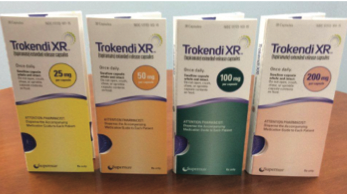Trokendi XR by Supernus Pharmaceuticals, Inc
Trokendi XR (topiramate) is an antiepileptic drug FDA approved for treating partial-onset seizures and primary, generalized tonic-clonic seizures in patients 10 years and older and for adjunctive use in children as young as 6 years with Lennox-Gastaut syndrome or partial-onset seizures.

On August 16, 2013, Supernus Pharmaceuticals, Inc, announced FDA approval of Trokendi XR (topiramate).1 Trokendi XR is an antiepileptic drug with indications for use as monotherapy in treating partial-onset seizures and primary, generalized tonic-clonic seizures in patients 10 years and older. The antiepileptic medication is also approved for adjunctive use in children as young as 6 years with Lennox-Gastaut syndrome or partial-onset seizures.2
Taking a dose of Trokendi XR <6 hours before or <6 hours after drinking alcohol is contraindicated. Use of Trokendi XR is also contraindicated in patients with metabolic acidosis who are taking metformin.2
Pharmacology and Pharmacokinetics
Although the exact mechanism of action of Trokendi XR is unknown, potential mechanisms include antagonism of voltage-dependent sodium channels, augmentation of the activity of gamma-aminobutyrate (GABA) at GABA-A receptors, antagonism of glutamate receptors, and inhibition of the enzyme carbonic anhydrase.2
Steady-state levels show less variation in patients taking Trokendi XR (26% to 42% variation between tests) compared with patients taking immediate-release topiramate (40% to 51% variation between tests). After repeat administration, the elimination half-life of Trokendi XR is approximately 31 hours.2
Dosage and Administration
Trokendi XR capsules are available in 4 strengths: 25, 50, 100, and 200 mg. Capsules may be taken with or without food, although the capsules should not be crushed or chewed and the contents of the capsules should not be sprinkled on food.2
Dosing requires careful titration, usually reaching 400 mg daily in patients receiving Trokendi XR as monotherapy, and 200 to 400 mg in patients using Trokendi XR as adjunctive therapy. Initial dosing may begin at 25 mg daily for 1 week, with a 25- to 50-mg increase in the daily dosage each week until adequate seizure control is reached. Specific dosing titration regimens and regimens for pediatric patients are listed in the product package insert.2
A 50% dosage reduction may be required for patients with a creatinine clearance <70 mL/min/1.73 m2 body surface area. However, because hemodialysis increases the rate of elimination of topiramate to a rate 4 to 6 times that of normal renal function, patients undergoing dialysis may also require supplemental dosing of topiramate before dialysis to maintain antiseizure activity.2
Clinical Trials
In 470 patients with epilepsy confirmed by 1 or 2 well-documented seizures in the 3 months prior to randomization, patients first received topiramate 25 mg daily for 7 days. At the start of the double-blind phase of the study, 470 patients were randomized to receive dose titration to a maximum daily dosage of 50 mg (n = 234) or 400 mg (n = 236). Time to occurrence of the first seizure was significantly longer among patients in the 400-mg-daily arm compared with patients in the 50-mg-daily arm (P = .0002). Dosing and efficacy were evaluated in 6 other multicenter, randomized, double-blind, placebo-controlled trials.2
Warnings and Precautions
Careful monitoring for fluctuations in lithium levels is recommended for patients taking both Trokendi XR and lithium. Coadministration of Trokendi XR may reduce levels of other antiseizure medications, including phenytoin or valproic acid. Similarly, levels of Trokendi XR may be reduced by coadministration with phenytoin, carbamazepine, valproic acid, or lamotrigine. In women using oral contraceptive medications, Trokendi XR may increase the risk of breakthrough menstrual bleeding, especially at dosages of topiramate higher than 200 mg daily. Trokendi XR is a pregnancy category D medication that may cause fetal cleft lip and cleft palate.2
Patients should be monitored for several possible adverse events, including hyperthermia, reduced sweating, metabolic acidosis, kidney stones, cognitive dysfunction, and mood problems. Patients should be cautioned to avoid operating heavy machinery when starting treatment with Trokendi XR due to the potential for somnolence, dizziness, and visual disturbance.2
In clinical trials, adverse events occurring >5% more frequently in patients taking Trokendi XR than in patients taking placebo included paresthesia, anorexia, weight decrease, fatigue, dizziness, somnolence, nervousness, psychomotor slowing, difficulty with memory, difficulty with concentration/attention, cognitive problems, confusion, mood problems, fever, infection, and flushing. For a complete discussion of potential drug interactions and adverse events that may occur with Trokendi XR, please consult the product package insert.2
Michael R. Page earned his PharmD from the Ernest Mario School of Pharmacy at Rutgers University. He has worked as a community pharmacist at CVS Pharmacy and is currently clinical editor in clinical and scientific affairs at Pharmacy Times.
References
- Supernus announces final FDA approval and upcoming launch of Trokendi XR [press release]. Supernus Pharmaceuticals website. Accessed February 2014.
- Trokendi XR (topiramate) extended-release capsules [package insert]. Rockville, MD: Supernus Pharmaceuticals, Inc; 2013.

